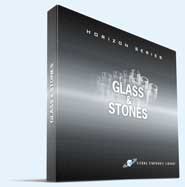Review by Carlos Garza
Originally published in Pro Audio Review
Provided on one DVD-ROM with 4.4 GB of samples at 16-bit/44.1 kHz. Glass and Stones includes glass harmonica, musical glasses, verrophone and lithophone. The EXS24 versions were tested with Logic 7 and HR824 monitors.
 VSL Horizon Glass and Stones The glass harmonica includes portamento, sustained and half-step trill articulations played with fingers and short notes glissandos played with mallets. The articulations for musical glasses include staccato, sustained, tremolo and a half-step trill. The verrophone is a set of glass tubes of different lengths mounted in a wooden stand. The tubes resonate at specific pitches, eliminating the need for water tuning. Verrophone samples are finger played with staccato and portato, sustained notes, tremolos and half-step trills. It’s also played with mallets in several variations including trills and glissandos. A lithophone is a natural or man-made instrument made of stone. VSL recorded a lithophone constructed with marimba-like bars and resonators. The VSL lithophone program offers a variety of playing techniques, including soft, medium and hard mallets, fingers, fingernails, stones and a bow. There are single notes, mutes and tremolos. The fingered verrophone has an almost vibes-like quality, especially the tremolo version. The lowest notes seemed very thick until I softened the throbbing fundamental and exposed the high frequency shimmer with an equalizer. The mallet glissandos on the verrophone have a mysterious quality that comes from both the whole tone-like scale and the sound, while the chromatic trills come across as a more metallic take on the angklung (see FX Percussion). Most of the lithophone articulations remind me of a marimba but are different enough to be distinctive. The low end is very warm and comforting. I lengthened the attack of a soft mallet instrument and, when the lowest notes were played with a slow pitch bend, it sounded like a large sea animal. There are plenty of unexpected sounds in the lithophone effects but my favorite is the bowed low-end sound. The forte samples of the glass harmonica have an edgy quality. The standard versions are designed to use less RAM but are suitable for general use. I found the versions with separate release triggered samples the most captivating and least “synth like.” For completely “out of this world,” try volume-fading chords or note clusters on the half-step trill sounds. Then throw in a pitch bend. Spooky stuff. Although the focus of this review is sound design, I have to add that the Glass and Stones set has many musical possibilities. The sustained glass harmonica can serve as an organic cousin of the Theremin. Less electronic but just as haunting. Designing a sound for friendly aliens or the spirit world? You might want to check out these sounds. (2) 2006 Carlos Garza |